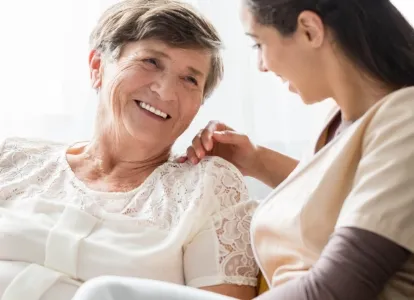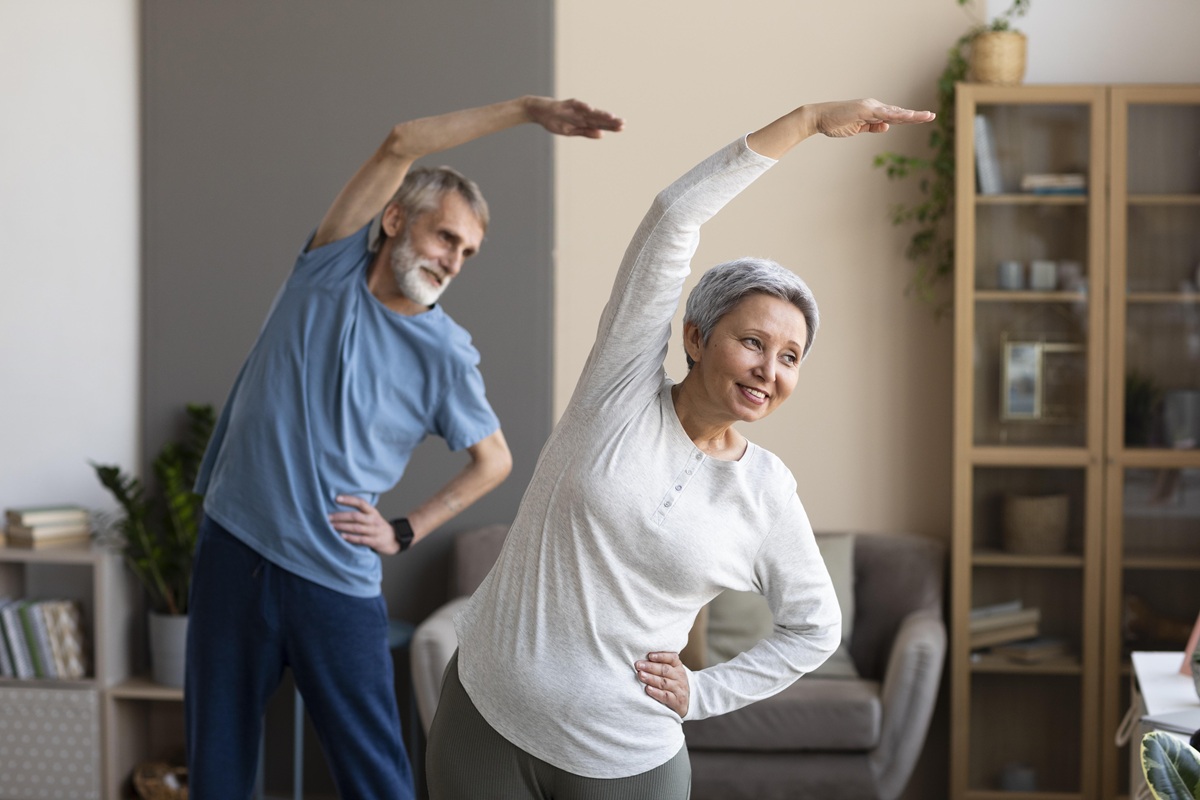Creating a Balanced Exercise Routine for Seniors
As we age, our bodies lose muscle mass and bone mass. Routine physical activity plays an important role in helping to offset this natural degeneration, while also building muscle to promote healthier aging. Developing a balanced exercise routine for seniors is an important part of healthy aging.
Why is Exercise Important for Seniors?
As we age, our bodies naturally experience changes, such as decreased muscle mass, flexibility, and balance. Staying physically active plays a crucial role in counteracting these effects. If your aging loved one has not remained active in their senior years, encourage them to being incorporating simple exercises in their daily lives. The benefits of this are enormous.
Exercise helps seniors improve mobility, allowing for more freedom in daily activities, whether it’s walking to the kitchen or climbing stairs. Regular physical activity for older adults also enhances balance, which is key to reducing the risk of falls – one of the most common causes of injury in older adults. Exercise is also proven to lower the risk of chronic diseases such as heart disease, diabetes, and arthritis, while also boosting mental well-being. 1 Exercise also helps reduce symptoms of depression and anxiety, improves mood, and keeps the mind sharp. 2
Building a Balanced Exercise Routine
Creating a well-rounded exercise routine is essential to promote strength, flexibility, and overall fitness.
Functional Fitness for Everyday Movements
For the best results, aim to perform functional fitness exercises three times per week, gradually increasing intensity as strength builds. Functional fitness focuses on exercises that mimic daily activities, helping older adults stay independent. Movements like sitting and standing repeatedly from a chair work the hips, knees, and hands, improving mobility for real-life tasks. A simple step-up exercise using a sturdy surface can strengthen the foot and knee, making climbing stairs easier. Holding onto a stable surface while practicing controlled left and right-side leg lifts can also enhance stability and improve balance.
Flexibility and Mobility Exercises
Our muscles and joints lose flexibility as we age. Without regular stretching, our muscles become tight and brittle, which can lead to experiencing pain, reduced mobility and even injury.
Simple stretches can significantly improve flexibility and reduce stiffness, allowing seniors to move more easily throughout the day. Neck rolls, shoulder rolls, and seated leg lifts are excellent starting points to help increase joint range of motion and alleviate muscle tension.
Improved mobility can make everyday activities easier and less painful. With regular stretching and joint rotation, your loved one may start reaching for that high shelf or bending down to tie shoes with more ease and less pain.
Balance and Stability Training
Balance exercises are a must for fall prevention, which is common among the aging population. Activities such as heel-to-toe walking or standing on one foot can help enhance stability. These exercises train the body to maintain control and body awareness, which can increase confidence reduce the likelihood of accidents. For extra support, seniors can perform balance exercises near a wall or sturdy chair.
Just be sure to incorporate proper footwear into this new workout routine to help reduce risk of injury. These sneakers for older men and shoes for older women are great options for supportive and stabilizing footwear for older people.
Completing these exercises regularly will help build muscle strength and stability, helping your aging loved one to feel more confident in their daily lives.
Strength-Training Workouts
Strength training is an excellent way to maintain and build muscle mass, which naturally decreases with age. Light, supportive strength-training exercises such as wall push-ups, chair squats, or light exercises with resistance bands are all great exercises for seniors. Strengthening muscles also supports bone health, which can help prevent or improve conditions like osteoporosis, which may accompany aging.
Floor Exercises for Core Stability
A strong core is essential for maintaining good posture and reducing back pain. Floor exercises like seated knee lifts or gentle leg extensions help stabilize the midsection and support overall movement. For beginners, modified plank holds on the knees are a way to strengthen abdominal muscles without excessive strain. If getting down on the floor is difficult, seated core twists while holding a light weight are a great alternative.
Start with 30 seconds per exercise, then repeat for a total of three minutes. Adjust based on comfort level and mobility needs.
Cardiovascular Activities
Cardiovascular exercises are essential for heart health by boosting circulation and energy levels. Low-impact activities such as walking, swimming, or stationary cycling are great options for the elderly population. These exercises allow the heart to remain strong without putting excessive strain on the joints. Walking with a friend will also help boost social interaction and may also help your loved one remain committed to their workout schedule. For those in assisted living, incorporating winter activities for nursing home residents like indoor walking clubs or light aerobics can provide a fun way to stay active during colder months.
Relaxation and Recovery
Movement is an essential part of healthy living and should be incorporated into daily routines. Yoga and meditation are excellent practices to turn to on days when perhaps your senior loved one is feeling tired or taking a day off from a more intense workout.
Meditation is scientifically recognized for reducing stress and promoting relaxation. Yoga is a great companion to meditation. This form of moving meditation also helps promote flexibility and stability, which will help strengthen overall mobility for your older relative.
These mindfulness exercises are also complimentary to strength-training activities by helping to elongate muscles and reduce stiffness, leading to an overall stronger and healthier feeling.
Tips for Exercising Safely
Exercise is a vital part of healthy aging, but safety should always come first. Here are a few tips to ensure seniors can stay active without injury:
- Consult with a healthcare professional: Before beginning any new exercise routine, seniors should consult with their doctor to ensure the activities are appropriate for their health condition.
- Start slowly: Begin your new routine with low-intensity exercises to avoid injury/ Gradually increase the intensity and duration of activity as your body adapts. You can also start from one to two times a week, eventually adding more exercise days to your regular routine as you build your strength and stamina.
- Use supportive aids: Whether you are using a chair for better stability or lightweight dumbbells to access weight training when first beginning, remember that any form of exercise is better than none.
- Proper footwear: Seniors should wear comfortable, well-fitting shoes to prevent slipping and reduce stress on joints.
How Adaptive Clothing Aids in Exercise
Adaptive clothing plays an important role in ensuring seniors can exercise safely and with ease. Features such as easy closures, elastic waists, and breathable fabrics such as cotton, help seniors move freely in day-to-day life. These men’s elastic waist pants and women’s elastic waist pants offer independence through dressing and increased comfort during these exercise routines. This extends to working out, where comfort does play a large part in the exercise routines.
Silverts’ nursing home collection is specially designed for seniors who are living in a facility. This collection includes stylish and functional clothing options that make it easier for seniors to move easily throughout workouts without being bothered by stiff fabrics or uncomfortable buttons and zippers.
Conclusion: Stay Active and Comfortable
Aging well means we must take care of our body and minds. Exercise plays an important role in maintaining our health as we get older. Regular physical activity can help improve quality of life through enhanced flexibility, balance, strength and lowered risk of certain disease.
Incorporating adaptive clothing and footwear into daily living is an added way to maintain comfort and confidence for elderly people. Including adaptive active wear into your loved one’s wardrobe can help encourage regular physical activity and play a successful role in healthy aging.
Visit www.Silverts.com to learn more.
Sources
- “Exercise and chronic disease: Get the facts.” Mayo Clinic. https://www.mayoclinic.org/healthy-lifestyle/fitness/in-depth/exercise-and-chronic-disease/art-20046049. Accessed on March 13, 2025 ↩︎
- Craft, Lynette L., and Frank M. Perna. “The Benefits of Exercise for the Clinically Depressed.” Primary care companion to the Journal of clinical psychiatry vol. 6,3 (2004): 104-111. doi:10.4088/pcc.v06n0301. Accessed on March 13, 2025 ↩︎





No Comments